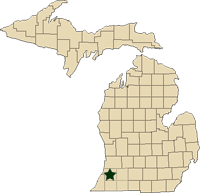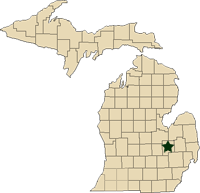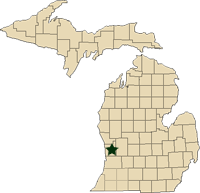Regional reports on Michigan fruit – August 30, 2011
MSU Extension educators’ pest and fruit updates for Michigan.
This week’s regional reports:
- Southwest Michigan - Mark Longstroth, Bill Shane, Diane Brown
- Southeast Michigan - Bob Tritten
- Grand Rapids Area Small Fruit – Carlos García-Salazar
Southwest Michigan – Mark Longstroth, Bill Shane, Diane Brown, Michigan State University Extension
|
Last week’s weather was pleasant and dry with highs near 80 and lows in the 50s. There was little rain last week. Soils are beginning to dry. This week is forecast to have highs climbing through the 80s to highs near 90 on the weekend. Find the closest weather station near you at Enviro-weather.
| Southwest Michigan Growing Degree Day Totals from March 1 through August 28 | |||
| Location | GDD 42 | GDD 45 | GDD 50 |
| Bainbridge | 3346 | 2929 | 2279 |
| Fennville | 3152 | 2749 | 2120 |
Tree fruit
Still unconfirmed reports of brown marmorated stink bugs in the area, but last week’s post brought several requests to view stink bug damage to apples and peaches. San Jose scales have been showing up on various fruit types.
Peach harvest continues. Bellaire harvest is complete. Loring, Redkist and Blushing Star are being harvested. Other varieties being harvested include Fantasia nectarines. Fruit size is excellent in the later varieties. Growers should monitor peach fruit.
Peach harvest continues with varieties picking much later this year than usual. Varieties being harvested include PF-23, Allstar, SweetStar, Contender, Glowingstar and Fantasia nectarines. Fruit size and quality is generally very good, although current dry weather is holding back fruit sizing in some sandy sites. Bacterial spot is a problem in orchards with susceptible varieties next to vegetable fields due to blowing sand earlier in the season. Trap catches of oriental fruit moth continue to be high in some orchards we trap, but not nearly the problems that we saw last year with fruit infestations.
In cherries, cherry leaf spot symptoms are spotty with new waves of yellow leaves appearing in some orchards. Many trees have been completely defoliated. Mature cherries can be pruned for a few more weeks, until early September.
Plum harvest continues, with Stanley, NY9 and Bluefree plums. Plums should be protected from brown rot and apple maggots. White apple leafhoppers will also attack plum leaves, causing white speckling on the leaves.
Apples are almost 3 inches in diameter and beginning to size well. Paula Red, Zestar and Early Mac harvest is ending. Gala, Macintosh and Honeycrisp harvest will begin this weekend for some growers. Processing varieties are being harvested. We are about five days later than the predicted apple harvest dates. Trap catches for oriental fruit moth increased this week, while codling moth trap catches declined. Flight of the summer generation of obliquebanded leafrollers is underway and apple maggot flies are out. The treatment threshold for European red mites is seven mites per leaf.
In pears, Bartlett harvest is underway. Codling moth is still being trapped in pears with numbers holding steady this week.
Small fruit
Japanese beetles are becoming very hard to find. Spotted wing Drosophila numbers should spike upwards in blueberries and other small fruit as insecticide applications end after harvest.
Grapes are coloring. Early table grape varieties are being harvested. Niagara harvest is forecast to begin on September 12 and Concord about 16 days later. The third generation of grape berry moth is out and laying eggs. Infested clusters range from none to 22 percent. Growers should be checking their vineyards to assess grape berry moth control and making decisions for additional treatments accordingly. Grape berry moth infestation should be kept to about 6 percent in vineyard interiors.
We are beginning to see defoliation from downy mildew in commercial Niagara vineyards. Downy mildew has also been observed in Concord grapes this year due to continued favorable conditions for this disease. Extensive periods of morning ground fog and dew allow the rapid spread of downy mildew, so preventative treatments should be continued. Phomopsis is showing up on berries at more locations as sugar levels increase in grape clusters.
Blueberry harvest is ending. Most growers have finished Elliotts, reporting low yields and poor berry size from later pickings. Overall most growers are disappointed by the poor yields in 2011. Spotted wing Drosophila may begin to show up in blueberries in Van Buren and Berrien counties. Soils are beginning to dry and growers should maintain soil moisture through September. Flower bud set for next year’s crop is underway and adequate moisture will help insure a good crop and vigorous plant next year. Fall is a good time to apply residual herbicides. For more information on fall weed control, see MSU horticulturist Eric Hanson’s article, Take advantage of fall weed management in blueberries.
Strawberry fields are generally growing well and running, except where potato leafhoppers have stunted growth. Seascape and Albion are two everbearing varieties being harvested.
In brambles, blackberry and fall raspberry harvest continues. Heavy morning dews can make gray mold a problem. Spider mites may also be an issue, especially in high tunnels. Growers should take time to assess injury levels and treat accordingly.
Southeast Michigan – Bob Tritten, Michigan State University Extension
|
Weather
While most fruit farms in the southeast region report that they have adequate moisture supplies, there are scattered locations where soils have dried out from recent rains and the early signs of drought stress are beginning to reappear. Signs of drought stress include some leaf wilting on newly planted tree and small fruit and for apple grower’s fruit that is not sizing well as it is nearing harvest. Other signs in blueberries include small fruit size, which is typical toward the tail end of the season, but is even more pronounced at these sites, and fall red raspberries berry size is diminished.
Our season is still running ahead of normal by about three to five days when I look at degree day totals. However, when I look at the beginning of harvest of several of our fruit crops, I think that for the most part we are about five days behind normal.
|
East Michigan Growing Degree Day Totals for March 1 to August 29 |
|||
|
Location |
GDD42 |
GDD45 |
GDD50 |
|
Commerce (Oakland) |
3254 |
2850 |
2216 |
|
Emmett (St Clair) |
3196 |
2795 |
2169 |
|
Flint (Genesee) |
3233 |
2826 |
2197 |
|
Lapeer (Lapeer) |
3224 |
2821 |
2194 |
|
Petersburg (Monroe) |
3424 |
3005 |
2350 |
|
Pigeon (Huron) |
3018 |
2625 |
2016 |
|
Romeo (Macomb) |
3297 |
2895 |
2268 |
Tree fruits
Apples continue to size where soil moisture has been adequate. Where soils have been dry, it seems as if apple size has stalled over the last two weeks or so. Gingergold and Zestar harvest have taken place at most farms. Many farms have done an early picking of Gingergolds and are allowing interior apples to color and size a bit better. I am going to begin collecting apple samples next Monday (September 5) for the Apple Maturity Project; the data that is generated will give me a better picture on maturity of McIntosh and Gala.
Apple insect pressure continues to be on the decline across the region. I am catching lower numbers of apple maggots, codling moths and oriental fruit moths in traps over the last week. European red mite numbers remain about the same, in that there are localized hot spots in many blocks of apples. Most of my fruit growers have chosen to let predators take care of the problem and they are doing so quite nicely. I have found predators feeding on eggs that have been laid in the calyx ends of apples. Sooty blotch and fly speck is just starting to be seen in a few blocks of apples.
Pears continue to size with most being around 2.75 inches where soil moisture has been adequate. Where soils have been dry, I have not seen pears take on any size over the last two weeks or so. Many growers are asking about timing of pear harvest. I believe that most blocks of Bartlett pears will be ripe around September 5 -7.
Peach harvest continues and will be completed later this week at most farms. Canadian Harmony and Bellaire harvest is complete. Some growers have seen light amounts of brown rot beginning to show up in later peach varieties. At many farms, later varieties are ripening very quickly and growers are concerned about soft fruit. Where soil moisture has been adequate, peach size has improved the later we move into the season.
Sweet and tart cherry leaf drop continues where post harvest fungicides have not been applied. In many blocks there are trees that are completely defoliated. I am also seeing many newly planted blocks of sweet and tart cherries where leaf drop is extensive from cherry leaf spot disease.
Plums continue to color very well and in the last week have put on a nice swell of size. Stanley plums should be ripe around September 15 or so.
Small fruits
Strawberries continue to put on new runner growth in newly planted fields. Many growers are considering an herbicide application in the next week or so in both newly planted fields and in renovated plantings. In many renovated plantings, weed control is poor this season.
Raspberry harvest continues for fall red raspberries. There are now enough berries ripening that farms are able to remain open for harvest. In the past few weeks, many farms have had to close to allow for further ripening. Consumer demand for raspberries remains very strong this year. Where Japanese beetles have been a problem, I am seeing just a few beetles left in most plantings and therefore they are not a serious issue. Growers need to be on the lookout for early signs of gray mold. Fall blackberry harvest looks like it will begin in about 10 days or so.
Blueberry harvest continues across the region however the season is winding down fairly quickly. Most growers were hoping to stay open through Labor Day (September 5), but that does not appear to be the case at several farms. Berry size has diminished greatly in the last week.
Grapes are coloring very well for the Concord types as they are reaching maturity. French hybrids are also beginning to color well. Grape berry moth flight continues with a good number being caught in traps over the last week. Powdery mildew and downy mildew symptoms continue to be seen at several farms.
Grand Rapids Area Small Fruit – Carlos García-Salazar, Michigan State University Extension
|
Raspberry and blackberry production is on the rise in west Michigan. At this time raspberries, blackberries and blueberries are the main crops that are being harvested. So far, raspberries are becoming one of the major small fruit crops in west Michigan; more raspberries are harvested this year than in previous seasons.
There are two reasons for this increase. First, there are new plantings in Kent, Ottawa, Allegan, Ionia and Allegan counties. These are one to two acre plots added to other berry production fields already exploited by berry growers (blueberry and strawberry growers, mainly). Especially for growers with U-pick operations or fruit stands, the addition of raspberries and blackberries to their fruit farm has been a smart addition. The only down side is that raspberries, as well as blackberries, have a very short shelf-life and growers need to harvest daily. If not enough customers are available at harvest time, these berries need to be kept in cold storage until a buyer is found. There are at least three new raspberry plantings in Ottawa County, all of them operated by blueberry growers.
Currently, major problems facing raspberry and blackberry production are weather and Japanese beetles. Hot weather that has prevailed for the last 15 days has created a problem for berry production as it accelerated fruit ripening and fruit rots. Some growers are having more berries than buyers and fruit rots are taking 10 to 15 percent of the fruit harvested. The Japanese beetle also deterred some clients from harvesting at U-pick farms. Some people are not willing to tolerate this nuisance while harvesting. However, fewer losses are reported due to Japanese beetle damage. Most of the losses are related to the need to apply pesticides to maintain beetles away from the crop, and the loss of customers.
For blueberries, the main variety harvested at this time is Elliott. In Allegan County, growers are already in the fourth hand harvests. But north of Allegan, Elliott fields are in the second and third hand harvests. Because of the size of the 2011 crop, blueberry prices for fresh blueberries are reaching more than $1.80 per pound. However, because of the light crop many growers are paying pickers up to $ 0.70 per pound. That is making blueberries more expensive for consumers. So far, the size of the 2011 crop remains below 70 percent of the 2010 crop. Problems reported by growers are mainly related to production.



 Print
Print Email
Email





